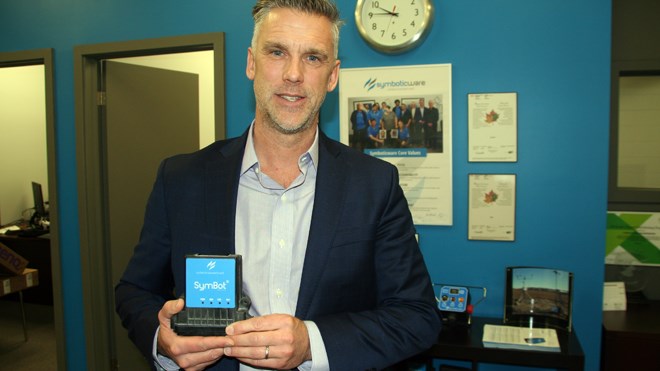The year 2008 wasn’t the best time to start a business based on a new and still immature technology, but Symboticware’s Kirk Petroski weathered the storm. Today, 10 years later, the company he founded is on solid ground and the telemetry technology it developed is all the rage.
Capping its first decade of success was the recent award of a multi-million dollar contract from Vale to equip all of its mines in Canada with telemetry, encompassing some 200 pieces of equipment.
Vale issued an RFP for the technology in 2016, evaluated the offerings from six vendors and awarded the contract to Symboticware in June 2017. The deployment began with Coleman and Copper Cliff mines, followed by Creighton Mine and the company’s Thompson, Manitoba operations.
To what does he attribute his success?
“We are the best in the world for underground mining, hands down,” said Petroski. “We have patents for the way we do store and forward for underground. That’s key. Not all telemetry devices have the ability to collect, store and transmit data in real-time, move the data through networks and integrate it with a data historian so it can be used.”
There are telemetry solutions for open pit and other surface operations, but the needs for underground are much more challenging because there are dark areas at the face where there’s no connectivity, he noted.
Another advantage Symboticware offers is that it’s vendor agnostic.
“In underground mining, you usually have mixed fleets, so you need an agnostic approach that allows you to interface with equipment from multiple vendors, and that interfacing is not trivial,” said Petroski.
The sale to Vale was important, but Symboticware also does business with a wide range of mining companies, including Alcoa, Barrick, Glencore, Dundee Precious Metals, Goldcorp, KGHM, Mitsui and Mississippi Lime.
Over the 10 years, the Symbot, which is essentially a ruggedized miniature computer, has shrunk from the size of a shoebox to a device that fits in the palm of your hand. Back in the day, they were assembled by hand. Today, they are churned out on an ultra-modern robotic assembly line in Ottawa.
“We were one of the first to enable short interval control in the mining industry – the ability to get data from a piece of equipment up to surface and then back down to an operator’s tablet so they can understand their task and make adjustments in near real- time. It’s the ability to tighten that loop of information, so you may have pure data that flows to surface and back to the operator in seconds.”
“With short interval control and a tablet in front of the operator, the operator can input what’s going on with production, including type of ore moved, delay codes, reasons for the bucket not being full or if the vehicle was used to move material other than ore. The operator has the daily tasks he has to do on the tablet, and he indicates job done, (or not). That information goes back to surface and it gets recorded. That’s where the industry is going.”
For KGHM, Symoticware developed machine to machine capability – an autonomous, decentralized peer-to-peer network.
“This means that two Symbots can talk to each other,” said Petroski. “So, if you have a data dark area at the face, you’re collecting data, but there’s no communication.”
When another Symbot-equipped vehicle comes by, the data is transferred from one to the other and eventually to surface when the mobile piece of equipment enters a WiFi enabled zone.
“What it means is we’re creating an informal network of Symbots that allows you to move data where you may not have a network.”
In the case of KGHM, Symboticware’s machine to machine capability allows for the capture of seismic monitoring data from smart bolts and transmission via Symbot equipped mobile equipment to surface.
Normally, a geologist goes to each one, plugs in, and logs the data maybe once a month. We’re enabling that potentially every four hours, so it increases the understanding of what’s happening in the mine.”
The Symbot interfaces with a wide range of components on a piece of equipment, capturing data on engine and transmission performance, tire pressure, payloads, speed, emissions, seatbelt use and more.
The savings on maintenance can be significant. Early detection of low tire pressure, for example, can prevent the premature failure of a tire, which can cost anywhere from $7,000 to $9,000. Similarly, avoiding the replacement of a transmission can save $100,000.
“The first six years were tough, especially after 2012 when spending dried up, but since 2016, we’ve seen a big push on telemetry,” said Petroski.
With the growing acceptance of the technology and channel partners in the U.S., Chile, Peru, Australia and South Africa, Symboticware’s next decade looks promising indeed.
Norm Tollinsky is the editor of Sudbury Mining Solutions Journal.
